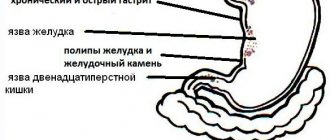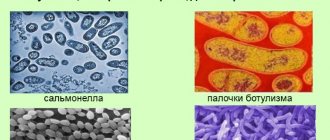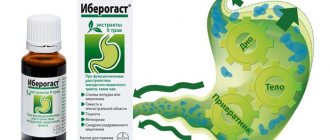Concept of gag reflex
Nausea is the feeling of imminent vomiting, and vomiting is the expulsion of stomach contents into the esophagus and mouth.
When the body wants to expel irritants penetrating into it, the following reflexes come into play:
- sneezing - removing them from the nose;
- cough - from the throat and lungs;
- diarrhea - from the intestines;
- vomiting - from the stomach.
The reflex action may include an increase in saliva production preceding an episode of vomiting.
Vomiting is a complex, coordinated reflex controlled by a specific area of the brain that responds to signals coming from:
- mouth, stomach and intestines;
- circulatory system that may contain drugs or infections;
- regulatory centers of the vestibular apparatus in the ear (as, for example, with seasickness or traveling in a car);
- other brain centers that process unpleasant sights, smells or thoughts.
Causes of vomiting before or after eating
Why does bloody diarrhea occur in a child under one year old?
Why a baby burps immediately after eating should not worry parents, as this is a normal occurrence in infants. Regurgitation does not cause discomfort in the baby, he behaves calmly. Sometimes this is observed after each feeding and is explained by the physiological characteristics of the infant’s digestive tract.
If a child burps after eating, not just releasing small volumes of swallowed milk, but has an attack of vomiting, accompanied by general malaise and nausea, then the reasons can vary from poor-quality food to various diseases.
Important! After vomiting, the child’s unpleasant symptoms often subside.
External reasons
If a child vomits while eating, this may be due directly to food entering the body, or less commonly to other external factors:
- Too much food eaten. The stomach strives to get rid of excess food. It is not accompanied by a deterioration in the child’s condition and does not recur if quantitative food standards are observed;
- A child's gag reflex may be triggered if he has eaten a heavy meal high in fat;
- Sometimes parents try to feed their baby, despite the fact that he does not want to eat at all or these particular foods. Sometimes a child may have a gag reflex even at the sight of food that he does not like. This is due to a psycho-emotional reaction to the consumption of junk food;
The baby does not like the sight of food
- Overwork and nervous stress.
Presence of diseases in the child
If vomiting caused by external factors can occur once, then in the presence of illnesses, it will be observed often when eating.
Diseases and painful conditions that stimulate the gag reflex:
- Poisoning from low-quality products. Moreover, if the mother ate them, toxins may also be present in breast milk. Other toxic substances are components of some medications that a nursing mother uses;
Important! Vomiting in case of poisoning may not occur immediately, but after 2-3 hours.
- The acute phase of diseases that disrupt the functioning of the stomach (among them are gastroenteritis and acute appendicitis);
- Rotavirus infection;
- Viral hepatitis;
- Food allergies. If a child eats new foods and immediately vomits, these may be symptoms of an allergy to them;
- Acetonymic vomiting. A fairly common disorder in children, caused primarily by a lack of carbohydrates in the diet and an excess amount of protein. As a result, “ketone bodies” are formed in the child’s body, primarily acetone, which, when ingested in the stomach, provoke vomiting. Often the child vomits immediately after eating. This condition is easily treatable or disappears spontaneously when the baby's diet becomes balanced.
Congenital diseases
A number of pathologies exist in a baby from birth:
- Pyloric stenosis. It occurs when hypertrophied muscle between the stomach and intestines narrows the passage and prevents the contents of the stomach from flowing into the small intestine. The baby eats well, but after eating he vomits violently every time;
Pyloric stenosis
- Pylorospasm. It is characterized by the inability of the muscle fibers of the pylorus (at the exit from the stomach) to relax normally. Occurs between the second and twelfth weeks after birth;
- A very rare cause of vomiting after eating in an infant can be cardiospasm of the esophagus. Typically, this congenital pathology manifests itself at an older age. Characterized by impaired esophageal motility and lack of relaxation of the lower esophageal sphincter during swallowing;
- Intussusception (obstruction). A disorder in which one segment of the intestine invades another. The involved segments block the intestines and blood flow. Appears in children from 3 to 36 months;
- Hereditary metabolic disorders - intolerance to gluten, lactose, glucose due to the lack of enzymes that break them down.
Symptoms of gluten intolerance
Additional symptoms for congenital pathologies are:
- lethargy and apathy;
- stomach ache;
- diarrhea, with some diseases there is blood in the stool;
- body temperature rises;
- labored breathing;
- signs of dehydration - decreased amount of urine, dry mouth, lack of tear fluid;
- weight loss.
Important! When vomiting is particularly severe and frequent, it may contain blood due to damaged blood vessels.
Symptoms of vomiting in diseases
If vomiting and nausea after eating do not cause a general deterioration in the child’s well-being or an increase in body temperature, in most cases they are caused by food factors. If vomiting is a sign of a developing disease, other symptoms are often added to it, which will help to make a correct diagnosis.
With food poisoning and intestinal infections, numerous vomitings most often occur, which are accompanied by diarrhea and increased body temperature.
An allergic reaction may also cause redness, rashes, and itching of the skin. With pyloric stenosis, a small child experiences intolerance to breast milk, profuse vomiting after each feeding, dehydration, low body weight gain.
If vomiting attacks are provoked by acute respiratory infections, additional symptoms are added to them - cough, runny nose, redness of the throat, high temperature.
An acute attack of appendicitis can be identified by such characteristic signs as the appearance of nausea, vomiting, and severe abdominal pain. With meningitis, encephalitis, and brain injuries, constant vomiting attacks are observed, which do not alleviate the baby’s condition at all. These may be accompanied by intense headaches, dizziness, and convulsions.
What to pay attention to
The child vomited at night - possible causes of nausea after sleep
If a child vomits after eating, parents should carefully monitor his condition, paying attention to a number of factors. This is necessary for correct diagnosis in medical institutions.
Circumstances of vomiting
When a child feels sick and then vomits after eating, parents should remember:
- what foods and drinks the baby ate;
- what activities or events preceded the onset of the attack;
- Have you had any illnesses in the last weeks, months or even a year?
Start of vomiting
A thorough analysis is required:
- when does vomiting begin (how long after eating);
- whether attacks recur and how often;
- suddenness of the attack, or there were some signs, complaints of malaise, for example, nausea, etc.).
Character of vomiting
Here you need to pay attention to:
- duration of gagging;
- whether they are accompanied by abdominal pain;
Abdominal pain in infants
- does the pain go away after the eruption of vomit, and does the baby’s general condition improve?
Consistency of vomit
Vomit should be carefully examined and determined:
- their total volume;
- color and presence of impurities.
Preventive actions
To prevent nausea, you must:
Avoid eating expired, low-quality food; It is necessary to do heat treatment of kitchen equipment; Medicines should be taken strictly according to the instructions; When experiencing motion sickness in transport, it is recommended to take appropriate medications. For example, Relanium, Medazipam, Prazepam; It is recommended to stay in smoky rooms as little as possible; You should walk more often and be in the fresh air, do exercises; You need to sleep at least eight hours a day; You should make a proper diet. When feeding newborns, dishes must be subjected to heat treatment;
Nausea is an unpleasant symptom that occurs due to various situations. If a child is sick, then first of all it is necessary to identify the cause of the illness. If the baby’s condition worsens, you should contact a professional specialist. In simple cases, you can use folk recipes.
It must be remembered that preventing nausea is easier than treating it.
When is a doctor's visit necessary?
Vomiting during ARVI in a child and after a viral infection
If a child vomits after eating, this is an alarming sign that requires consultation with a pediatrician when:
- the baby is not yet three years old;
- vomit contains blood and is the color of ground coffee or bright green;
- attacks recur for 48 hours or more;
- temperature rises;
- similar symptoms appear in other family members;
- skin rashes appear;
- there is severe abdominal pain;
- diarrhea or severe constipation.
Important! Children who show signs of dehydration (rare urination with dark-colored urine, dry mucous membranes, etc.) should undergo an urgent medical examination. Infants are much less tolerant of dehydration, and it occurs more quickly than in adults.
Children who have had a single episode of vomiting with or without diarrhea, who are drinking enough fluids and who have no other signs of distress, rarely need medical supervision.
First aid for a vomiting attack
The main thing that parents should do is to ensure that dehydration does not occur.
The drug "Regidron"
When you gag, you don’t need to try to stop it; let the body expel the substances that irritate it. After vomiting you should:
- Provide peace for the child, try not to encourage active games, do not use children's swings and similar structures;
- You should not feed your baby for about 6-8 hours after vomiting. Then start feeding carefully, in small portions and light foods;
- It’s good if the child falls asleep - sleep helps empty the digestive system through the intestines;
- Give the child to drink from a teaspoon at short intervals. If vomiting has occurred repeatedly, then you need to use agents that restore the water-salt balance, such as Regidron.
Important! It is not recommended to give your baby sweet drinks.
Tips for parents
- If vomiting occurs after eating, the child should stop eating food for the whole day. This rule excludes infants who are fed breast milk;
- you need to calm down first of all in order not to make stupid mistakes in a panic and not harm your child;
- if vomiting occurs a second time, call a doctor immediately;
- You need to immediately measure the baby’s temperature, ask about his well-being, and examine the skin of the entire body for the appearance of a rash;
- Under no circumstances should you give your child fatty foods, as this could be the reason for vomiting;
- give plenty of fluids: still mineral water, clean water, which can be salted to avoid dehydration;
You need to understand that in this case you should not self-medicate, even if the vomiting was one-time, you should bring the child for a qualified medical examination to exclude pathologies and for your own peace of mind. It is always easier to prevent the development of a disease than to suffer from its consequences later.
Diagnosis and treatment
Correct diagnosis of vomiting is possible only in a medical facility. For most children, no special tests are required. However, when abdominal pathology is suspected, diagnostic tests are performed.
Examination of a baby by a pediatrician
If an inherited metabolic disorder is suspected, blood tests are performed. If dehydration is at risk, a blood test is done to measure the levels of electrolytes (minerals needed to maintain fluid balance in the body).
Treatment methods depend on the diagnosis:
- In case of poisoning, sorbents are prescribed (Smecta, White Coal, etc.);
- To restore water balance, rehydrating drugs are used (mainly Regidron);
- In the presence of congenital and acquired diseases, appropriate therapy is carried out, sometimes requiring surgical intervention, but more often drug treatment and a strict diet. Antihistamines are used to treat food allergies.
Vomiting in children after eating is most often caused by dietary errors or rotavirus attack. In most cases, the body recovers quickly. It is especially important to provide the child with sufficient fluids and maintain a rest regime.











